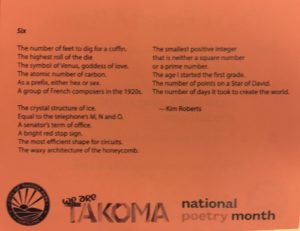
In The Scientific Method, Kim combines poems about Thomas Alva Edison and Carl Sagan, the strange mating habits of invertebrates and fish, and rondeaux about the United States presidents. She investigates the fascinating and tangled history of science, then applies that same precision to examine what it means to be Jewish and a resident of the American capital, Washington, D.C.
Reviews, Interviews, and Reprints from the Book
A review in Poet Lore by Anne Harding Woodworth (Fall/Winter 2018) states: “Roberts’s alertness to poetic forms and a keen sense of the absurd abound in this collection.” She praises the poems that uncover “science in all its different guides, personalities, theories, histories, triumphs, and errors.”
In an hour-long podcast for Writer’s Bone, Kim talks with Daniel Ford, Sean Tuohy, and Melanie Padgett Powers about The Scientific Method, her writing process, and how living in Washington, DC has influenced her poetry and her research. In light of the current presidential administration, she states, “Culture is more important than ever.” Published Oct. 9, 2017.
 Kim was interviewed by Josephine Reed for ArtWorks, the podcast series of the National Endowment for the Arts, in May. She read poems and discussed her latest book, her background, and what inspires her poetry.
Kim was interviewed by Josephine Reed for ArtWorks, the podcast series of the National Endowment for the Arts, in May. She read poems and discussed her latest book, her background, and what inspires her poetry.
 An excerpt of the title poem, “The Scientific Method: Chemistry Laboratory,” is featured in the Wick Poetry Center’s Traveling Stanzas project. Science Stanzas, curated by Jane Hirshfield, is a series of poems printed onto seven-foot banners, exhibited at the National March for Science in Washington, DC in May 2017. The poems are now traveling the US.
An excerpt of the title poem, “The Scientific Method: Chemistry Laboratory,” is featured in the Wick Poetry Center’s Traveling Stanzas project. Science Stanzas, curated by Jane Hirshfield, is a series of poems printed onto seven-foot banners, exhibited at the National March for Science in Washington, DC in May 2017. The poems are now traveling the US.
A review in Innisfree Poetry Journal by Mary-Sherman Willis (issue 25, Fall 2017) states: “Kim Roberts’s poems…are like canny experiments in lived life—hers, and those of the men and women who worked to study and codify the world around us. Think of the experimental lab report in science class, its empirical precision, its grounding in observation and measurement, its technical vocabulary, and you get a sense of this book. Add to that a series of ‘Eureka!’ moments of discovery and understanding. You will feel like you’re in the company of a smart museum docent who speaks in verse and has a sense of humor.”
 A poem from the book, “Six,” was featured in Takoma Park, MD’s Poem-in-Your-Pocket Day in April 2017, and reprinted in Intersections: Poetry with Mathematics in Spetmber 2017. Another poem from the book, “Quebec Place NW, Park View neighborhood,” was featured in the Park View blog in April 2017 for National Poetry Month.
A poem from the book, “Six,” was featured in Takoma Park, MD’s Poem-in-Your-Pocket Day in April 2017, and reprinted in Intersections: Poetry with Mathematics in Spetmber 2017. Another poem from the book, “Quebec Place NW, Park View neighborhood,” was featured in the Park View blog in April 2017 for National Poetry Month.
From a review in The Journal of Martinsburg, WV by Sonja James, March 2, 2017: “Kim Roberts’s The Scientific Method is a fascinating series of poems by one of D.C.’s finest poets. Roberts connects intellectual energy with historical insight in poems that reverberate with significance. Beautiful, bold, and passionate, these poems capture and celebrate the enduring nature of the human spirit. Roberts is magnificent.”
Read an interview with Kim by Grace Cavalieri (Washington Independent Review of Books, February 14, 2017) in which “the poet explains her endless fascination with science.”
Three poems from the book were reprinted in Origins Journal in February 2017.
Advance Praise
“Kim Roberts’s poetry uses a passionate microscope: it brings us into sudden intimate contact with the strange neighborhoods of the body, the mind, and of the living stone of the city. The Scientific Method ranges from the body’s ‘dark grottoes’ of ‘small words / long forgotten’ in the hammer and anvil of the ear, to the moon of 1836, where ‘a race of flying men,’ were seen praying in ‘sapphire temples.’ With Elizabeth Bishop’s eye for vivid detail, Roberts shares the names for aluminum conductors, ‘lupine, valerian, narcissus,’ and the curious mineral threads of radiola: ‘spiked crowns, chandeliers and lobed planets.’ A book of wondrous discoveries, and luminous portraits.” —David Gewanter
“Kim Roberts is preeminent as a writer of ‘science poetry.’ The Scientific Method looks at icebergs, oysters, astronomy, chemistry, labs, T-cells—language immersed in the many fascinations of life on earth. There’s a fire inside this poetry where intrigue led to imagination, commanding the page with startling lines, esthetics, and tonal geography. We have here a hallmark: intelligence and passion turning practical facts into poetic truths. This is a master work by a master poet.” —Grace Cavalieri
“With linguistic and formal diligence as well as wonder and curiosity, Kim Roberts has written a smooth-reading collection of poems that respects a reader’s intelligence without denying that we come to poems for more than scientific or historical data. This is a book that loves its terminology—Latin or otherwise. It also loves its humble questions—‘Is the chimney a chute of air […] Or is the chimney the bricks,//the mason’s careful art?’ And such questioning can be applied to poetry. What is the poem—the veracity of its elements or the alchemy? The Scientific Method’s answer is ‘both.’” —Kyle G. Dargan
Sample Poems
CASEUS
“How can anyone be expected to govern a country with 325 cheeses?”
—Charles de Gaulle
Caesar ate his first blue cheese
Just west of Rocquefort,
in the town of Saint-Affrique.
In Latin it was caseus,
which became cacio in Italian,
queso in Spanish, queijo
in Portuguese. Cheese.
The Roman farmer Columella
described how to get rennet
from the fourth stomach
of a lamb, how to add it
to fresh milk, how long to wait
for the milk to curdle,
how to press the whey out,
how to salt the curds until dry.
In The Odyssey, the Cyclops
drained his curds in wicker baskets
lining the walls of his cave.
The baskets gave the cheese
its form—in Greek formos—
in Italian formaggio, in French
fromage. Virgil ate fresh cheese
with chestnuts. The techniques
of ripening and airing, affinage,
are secrets passed down
thousands of years. Right now,
in some cave in France,
a farmer is carefully turning
each wheel, salting one side,
watching the mold emerge.
THE INTERNATIONAL FRUIT OF WELCOME
A pineapple is the perfect gift
to bring to a blind date.
A pineapple is like a blind date:
spiky and armored at first,
with the hope of sweetness inside.
A pineapple is the perfect housewarming gift.
You don’t have to wrap it,
it doesn’t spill inside your car.
It comes in its own house.
A pineapple is the perfect birthday gift.
You might prefer a coconut,
that planet molten at the core,
but the pineapple has a better hairdo,
better wardrobe; it never
goes out of style.
Think of all those historic houses
with pineapple bolsters, pineapple finials,
pineapples carved above lintels.
Such a sophisticated fruit:
every sailor wants one.
 Corona/Crown
Corona/Crown